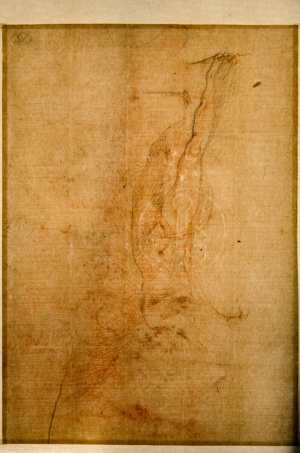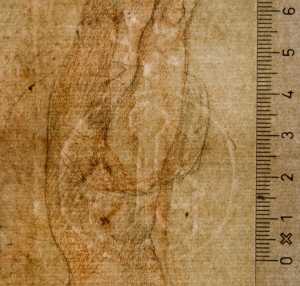Specifications
| Title | Study of an Angel |
|---|---|
| Material and technique | Black and red chalk |
| Object type |
Drawing
> Two-dimensional object
> Art object
|
| Location | This object is in storage |
| Dimensions |
Height 206 mm Width 145 mm |
|---|---|
| Artists |
Draughtsman:
Giuseppe Cesari il Cavaliere d'Arpino
|
| Accession number | I 376 (PK) |
| Credits | Loan Stichting Museum Boijmans Van Beuningen (former Koenigs collection), 1940 |
| Department | Drawings & Prints |
| Acquisition date | 1940 |
| Creation date | in circa 1585-1590 |
| Watermark | anchor in a circle, with a six-pointed star on top (62 x 41 mm, upside-down, in the centre, on P3 of 6P, vH, fine paper, folio), common type found in archival documents in South Germany, Austria, Italy, esp. in the early 16th c., comparable with Briquet 480 (a.o. Rome 1513, Vicenza 1515), Briquet 488 (Ferrara 1583), Piccard Online AT3800-PO-119079 (Tirol 1511) [see 2 images] |
| Inscriptions | ‘[…] peme[…] / ‘L. pem[…]’ (r.m., pencil, cut off at edge of sheet), 'Parmigian / Florentinisch' (verso, pencil) |
| Collector | Collector / Franz Koenigs |
| Provenance | Art dealer Julius W. Böhler (1883-1966), Lucerne; Franz W. Koenigs (1881-1941, L.1023a), Haarlem, acquired in 1929 (Florentine, early 16th century); D.G. van Beuningen (1877-1955), Rotterdam, acquired with the Koenigs Collection in 1940 and donated to Stichting Museum Boijmans Van Beuningen |
| Exhibitions | Amsterdam 1955, no. 165; Rotterdam 2009-2010 (coll 2 kw 5) |
| Internal exhibitions |
De Collectie Twee - wissel V, Prenten & Tekeningen (2009) |
| Research |
Show research Italian Drawings 1400-1600 |
| Literature | Amsterdam 1955, no. 165, pl. 47; Bolzoni 2013, p. 189, under no. 31; Röttgen 2013, no. 35 |
| Material | |
| Object | |
| Geographical origin | Italy > Southern Europe > Europe |
Do you have corrections or additional information about this work? Please, send us a message

























